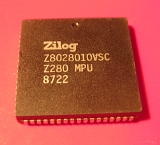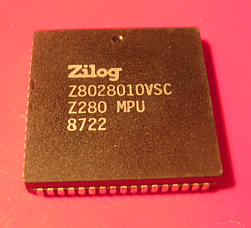
Zilog Z280
Encyclopedia

Zilog Z80
The Zilog Z80 is an 8-bit microprocessor designed by Zilog and sold from July 1976 onwards. It was widely used both in desktop and embedded computer designs as well as for military purposes...
architecture introduced in July 1987, basically a slightly improved CMOS
CMOS
Complementary metal–oxide–semiconductor is a technology for constructing integrated circuits. CMOS technology is used in microprocessors, microcontrollers, static RAM, and other digital logic circuits...
version of the earlier NMOS
NMOS logic
N-type metal-oxide-semiconductor logic uses n-type metal-oxide-semiconductor field effect transistors to implement logic gates and other digital circuits...
Zilog Z800
Zilog Z800
The Zilog Z800 was a 16-bit microprocessor designed by Zilog to be released in 1985. It was instruction compatible with their existing Z80, and differed primarily in having on chip cache and MMU for a 16 MB address range, and also a huge number of new more orthogonal instructions and addressing modes...
, both versions were commercial failures. They added a memory management unit
Memory management unit
A memory management unit , sometimes called paged memory management unit , is a computer hardware component responsible for handling accesses to memory requested by the CPU...
(MMU) to expand the addressing range to 16 MB
Megabyte
The megabyte is a multiple of the unit byte for digital information storage or transmission with two different values depending on context: bytes generally for computer memory; and one million bytes generally for computer storage. The IEEE Standards Board has decided that "Mega will mean 1 000...
, features for multitasking
Computer multitasking
In computing, multitasking is a method where multiple tasks, also known as processes, share common processing resources such as a CPU. In the case of a computer with a single CPU, only one task is said to be running at any point in time, meaning that the CPU is actively executing instructions for...
and multiprocessor
Multiprocessor
Computer system having two or more processing units each sharing main memory and peripherals, in order to simultaneously process programs.Sometimes the term Multiprocessor is confused with the term Multiprocessing....
and coprocessor
Coprocessor
A coprocessor is a computer processor used to supplement the functions of the primary processor . Operations performed by the coprocessor may be floating point arithmetic, graphics, signal processing, string processing, or encryption. By offloading processor-intensive tasks from the main processor,...
configurations, a 256 byte cache, and a huge number of new instructions and addressing modes (giving a total of over 2000 combinations). Its internal clock signal
Clock signal
In electronics and especially synchronous digital circuits, a clock signal is a particular type of signal that oscillates between a high and a low state and is utilized like a metronome to coordinate actions of circuits...
ran at 2 or 4 times the external clock's speed (e.g. a 16MHz CPU with a 4 MHz bus
Computer bus
In computer architecture, a bus is a subsystem that transfers data between components inside a computer, or between computers.Early computer buses were literally parallel electrical wires with multiple connections, but the term is now used for any physical arrangement that provides the same...
). Later, more successful, enhancements to the Z80-architecture include Hitachi
Hitachi, Ltd.
is a Japanese multinational conglomerate headquartered in Marunouchi 1-chome, Chiyoda, Tokyo, Japan. The company is the parent of the Hitachi Group as part of the larger DKB Group companies...
HD64180
HD64180
The HD64180 is a Z80-based embedded microprocessor developed by Hitachi with an integrated memory management unit . The Hitachi HD64180 "Super Z80" was later licensed to Zilog and sold by them as the Z64180 and with some enhancements as the Zilog Z180. It has the following features:* Memory...
and Zilog eZ80
Zilog eZ80
The Zilog eZ80 is an 8-bit microprocessor which is essentially an updated version of the company's earlier Z80 8-bit microprocessor.The eZ80 is binary compatible with the Z80 and Z180, but almost four times as fast as the original Z80 chip at the same clock frequency...
, among others. See further Zilog Z800
Zilog Z800
The Zilog Z800 was a 16-bit microprocessor designed by Zilog to be released in 1985. It was instruction compatible with their existing Z80, and differed primarily in having on chip cache and MMU for a 16 MB address range, and also a huge number of new more orthogonal instructions and addressing modes...
.

